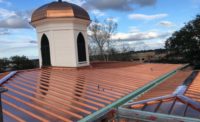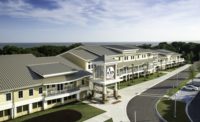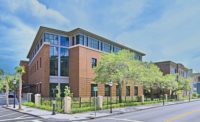Condominium owners take great pride in the buildings they call home. When repairs are needed, they’re inclined to undertake painstaking research before approving the contractors and building materials used for those repairs. Owners of the Versailles Condominiums proved no exception, shouldering a level of due diligence that might have impressed even veteran attorneys.
An eight-story, 86-unit structure mere steps from the Pacific, the Versailles stands in the upscale historic district of Long Beach, Calif. Its location amid gracious 1920s-era Craftsman-style homes and buildings, as well as its views of the Port of Los Angeles, Queen Mary and Catalina Island, are among many traits that make the French-inspired structure a highly-sought residential building.
Replacement of the failing metal roof system on the mansard structure called for a roofing material to meet the demanding criteria of both the condominium owners and the city of Long Beach. First, the material chosen needed to display an elegant appearance consistent with the structure’s vintage charm and the sophistication of the surrounding area.
Second, the material had to meet the fire safety requirements of the city, which called for the utilization of 100 percent non-combustible systems, right down to framing. Even the use of fire-treated plywood was deemed unacceptable by the city’s fire codes, which mandate steel or metal be featured in such projects.
Third, the material had to solve the problem of rainwater penetrating the building’s existing standing-seam aluminum roof, an issue resulting in leaks that had plagued the Versailles Condominiums and their owners for years.
The fourth criterion was installation. The selected material would need to be installable with minimal disruption to pedestrian traffic at street level.
A final guideline was that the material chosen would have to stand up to substantial wind loads off the Port of Los Angeles. The winds would be certain to impact the building sooner or later, particularly during fierce coastal storms.
For contractor McDonnell Roofing, the one material that stood out as meeting each of the criteria set forth by residents and the city was InSpire Slate, manufactured by The Tapco Group.
Having worked with the material for three years, McDonnell Roofing owner and president Gene McDonnell and CEO Tony Williams knew InSpire would meet the challenge. “Everyone seems attracted to the look,” said McDonnell, a veteran roofer with more than 30 years in the industry. “We use it for specific jobs, especially those catering to the high-end market. In situations where the roof pitch is such that you can step back and see the roof as well as the structure and windows, homeowners like its appearance.”
In addition to recognizing the appeal of its authentic slate look, McDonnell and Williams knew InSpire could be easily installed. “It’s very easy to put up, that makes it attractive to us,” McDonnell said.
Comparing Inspire to quarried slate, Williams noted, “InSpire is to everybody’s benefit from a safety standpoint and a weight standpoint,” said Williams.
McDonnell Roofing crews installed the tiles from the top of the building using a window cleaner’s staging area and davit system, allowing limited workspace. “With natural slate, installers need to drill a hole in the slate piece in order to nail it to the roof, and it’s fragile. InSpire is an easier, lighter application.”
“We do a significant amount of mansard roofs. We love the challenge,” McDonnell explained. “In working with a lot of homeowner associations and property management companies, especially with mansard roofs, we try to reach out to them, along with architects and general contractors, to let them know there are options like InSpire.”
Not only did Class-A fire-rated InSpire meet Long Beach fire codes, but the roofing company also knew it was also the best material to complement the fire-safe sheathing. “Fire is always on people’s minds here, especially when it comes to applications like high-rises and wood shake roofs,” McDonnell noted. “Fire rating is definitely part of the discussion with property owners and they want it to be up to code.”
McDonnell Roofing also recognized InSpire was a fit for its increasingly green and overall advanced approach to roofing, as it strives for innovation and safety, from solar installations to commercial single-ply applications. For example, InSpire is eligible for several green building certification credits, and its Sand-color Slate is certified cool roofing, making it ideal for dual goals of energy efficiency and beauty.
The next step in the Versailles project was convincing the condo board of the wisdom of using InSpire. “What sold InSpire was its authentic slate look,” McDonnell recalled. “When I brought it to a condominium board meeting with about 50 homeowners participating, everyone just looked at it and fell in love with it.”
Along with the product’s good looks, the company’s warranty helped bolster the case for installation. Having won the nod of the condo board, McDonnell next appeared before a City of Long Beach historic review panel to ensure the look of the completed roof would be consistent with that of the many historic buildings nearby. Armed with the structural engineer’s blueprint, McDonnell met with members of the panel and was eventually asked what material he intended to install.
He showed the panelists an InSpire product brochure and actually passed around a section of InSpire, McDonnell recalled. “They were very interested, and again exceptionally impressed. They had all the city inspectors and engineers come over and look at it right then and there. The woman I was dealing with said, ‘Let me bring it to the lead inspector in charge of the historic review.’ She was gone 20 minutes, came back and said, ‘It passed,’” he laughed. “It was quite a compliment to InSpire.”
Before installation could begin, many technical details necessary to satisfy the project engineers and city had to be resolved. At one point, McDonnell and colleagues traveled as far as Las Vegas in a vain attempt to find similar projects.
Through this period, they were able to depend on a crucial ally in the InSpire product team, which even went so far as to wind-test the fasteners to be used in the project. The roofing manufacturer’s eagerness to dig in and overcome obstacles impressed Williams. It was clear to him that InSpire executives’ desire to tackle challenges head-on reflected the confidence they had in their product.
“Other companies just said, ‘My job is only to sell this stuff. I don’t want to work this hard, this is too much of a challenge,’” he said. “InSpire was literally the only roofing manufacturer that said, ‘This is a challenge, this is fun, let’s do it,’ and said they wanted to turn it into a showcase.’ The technical side of this project really sets them apart with application versatility compared to their competition.”
Once the project was complete, Versailles Condominium homeowners weighed in, calling the new roof a huge improvement both aesthetically and functionally, McDonnell said. “The finished product was the clincher,” McDonnell added. “No one really knows what it’s going to look like fully applied on their building. Once it was on, the reaction was, “Wow! We’re glad we selected it.’”
For more information about the product, visit www.inspireroofing.com.





